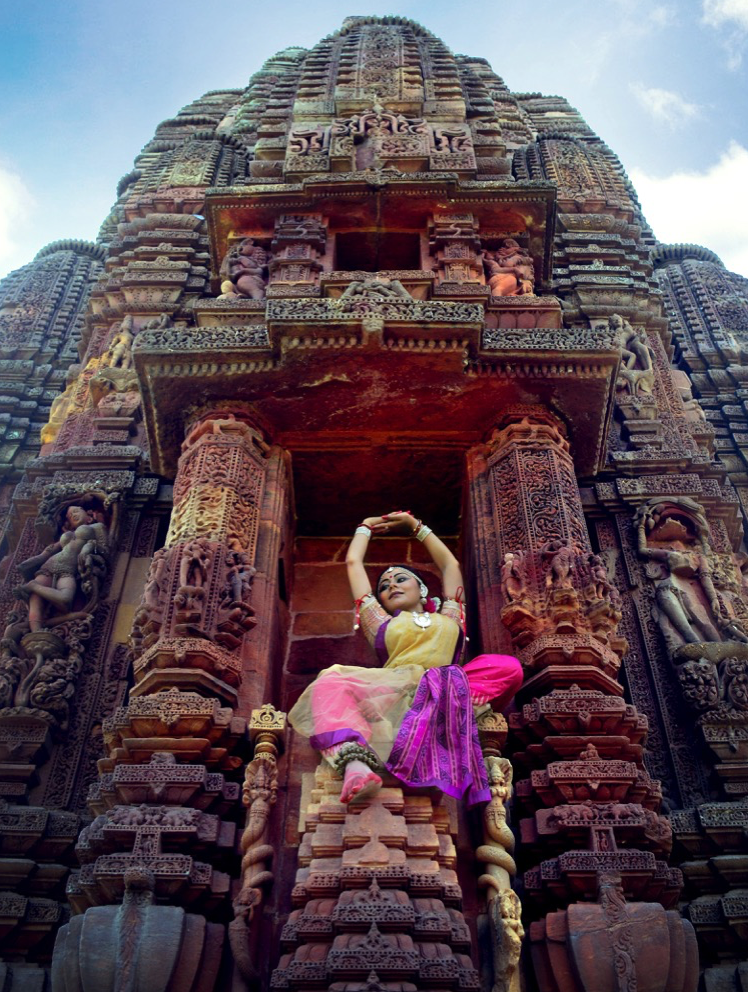A Brief History of Odissi | Digitally Repurposing Odissi | Odissi Gesture and Textuality
A Brief History of Odissi
Dance historians have successfully traced the lineage of present-day Odissi to archaeological, sculptural, architectural, textual, and embodied traces for the past two millennia through the rule of various kingdoms and dynasties with multiple religious affiliations, in Jainism, Buddhism, Hinduism, Islam, and Christianity. Dance in Odisha, the state where Odissi originates, has had a flourishing existence since second century B.C. due to the political and artistic patronage by several kings belonging to multiple dynasties and multiple religious affiliations patronizing the lineages of Maharis or temple-dancers and Gotipuas or young boys dressed as female dancers as embodied harbingers of present-day Odissi (Maitra, 1970, p. 165). Mahari dancing has been a central form of worship in the Jagannath temple in Odisha since the twelfth century; Jagannath is a Hindu male god who is also the presiding deity of Odissi.

Kaustavi Sarkar poses in Odissi performance costume, balanced in a niche of the Rajarani Temple in Bhubaneswar, Odisha, India. Photo credit Debojyoti Dhar. See also an example of Odissidance in a live performance context.
Odissi dance, originating from the eastern Indian state of Odisha, is retrospectively constructed in postcolonial India as a two-thousand-year-old tradition historically practiced by Maharis and Gotipuas. It is first mentioned as Odramagadhi in Bharata's Natyasastra, the oldest performing arts treatise written around 200 B.C. Archaeological evidence of dancing figures from the Hatigumpha and Ranigumpha caves in Odisha show that it is the oldest of all the classical dance forms of India. Inscriptional evidence in the numerous Odishan Hindu temples proves the presence of dancing inside the temples. While both Maharis and Gotipuas provide historical continuity to Odissii from the Natyasastric era to the contemporary context, the Maharis themselves have ceased to exist. Their millennia-long tradition in Odisha ended with the death of Sashimoni Devi, the last surviving Mahari, on 19 March 2015. Gotipuas continue to exist alongside Odissi in the contemporary proscenium theatre, folk festivals, art exhibitions, and international performance venues.
Reconstructed in the middle of the 1950s by the Jayantika cluster of cultural revivalists, dance teachers, musicians, historians, and aestheticians, significant research went into the inter-modal synthesis of the dance form from heterogeneous movement traditions, along with multiple media and their associated technologies. During its inception, the dance found resonance with temple sculpture, Mahari ritual, Gotipua dancing, Patachitra painting (palm-leaf painting), and the written treatises such as the Natyasastra, Abhinaya Darpana, and Abhinaya Chandrika. The textual emphasis in Indian classical dance superseded all other influences, leading to the marginalization of the Maharis and the Gotipuas in the form. Meduri (2005) notices a similar trend in the construction of the southern Indian classical dance form called Bharatnatyam from Tamil Nadu. She argues that the Indian classical dancing body is disembodied and can be read as a linguistic text, as each gestural representation has a corresponding textual interpretation. However, the influence of sculpture differs in Odissi from Bharatnatyam due to the ways in which the former creates visual iconography from the dancing body in ways that depart from textual overdetermination: the dance is the navigation from one static sculptural pose to another. For example, both Odissi and Odishan sculpture bear the similar definition for Tri Bhanga, a tri-bent posture with distinct bends at the knees, waist, and the neck creating an S-curve in the dancing body. Both sculpture and movement share the same principles in the Natyasastra, indicating that writing the body across media have long been of concern to Odissi theorists and practitioners.










